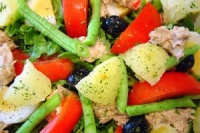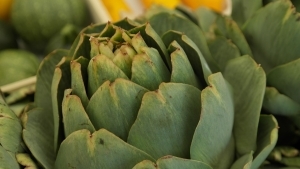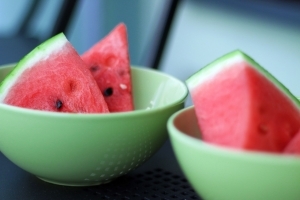Cooking all things duck
Food writer Jenny Garing's favourite duck recipes and tips

Bohemian roast duck Photo: Jenny Garing
Best-ever Duck Fat Potatoes
Believe me, I have tried a few methods, and this is definitely the best. Make sure you cut the potatoes into big chunks to maximise the crunchy exterior with a soft fluffy interior. The baking soda really does help, as alkaline water breaks down the surface of the potato creating loads of starchy slurry for masses of crispy crunch. Make sure your fat is REALLY hot when you add the potatoes.
Ingredients
- salt
- ½ teaspoon baking soda
- 2kg floury potatoes, peeled and cut into quarters
- 5 tablespoons duck fat
- 1 tablespoon rosemary leaves, finely chopped
- 3 medium cloves garlic, minced
- Freshly ground black pepper
Preheat oven to 230°C. Bring 2 litres of water in a large pot to the boil. Add 2 tablespoons of salt, baking soda, and the potatoes and stir. Return to a boil, reduce to a simmer, and cook until a knife meets little resistance when inserted into a potato chunk, about 10 minutes after returning to a boil.
Meanwhile, combine duck fat with the rosemary, garlic, and a few grinds of black pepper in a roasting tray. Cook in the oven until garlic just begins to turn golden, about 3 minutes. Immediately take it out and strain the fat through a fine-mesh strainer into a large heatproof bowl. Set the garlic/rosemary mixture aside and keep for later. Put the fat back into the oven tray and keep it hot in the oven.
When the potatoes are cooked, drain carefully and let them rest in the pot for about 2 minutes to allow excess moisture to evaporate. Shake them a little- to rough up their surfaces. Transfer them to the oven tray with the infused fat, season to taste with a little more salt and pepper and toss to coat thoroughly.
Spread them out evenly and roast, without moving, for 20 minutes. Carefully release any stuck potatoes, shake the tray to turn the potatoes. Continue roasting until potatoes are deep brown and crisp all over, turning and shaking them a few times during cooking, 30 to 40 minutes longer.
Serve them mixed with the garlic/rosemary mixture and more salt and pepper if needed.
Basic Duck Breasts
Heat an ovenproof frying pan to a medium heat and pre-heat the oven to 190°C. Pat dry the duck breasts and score the skin in a crisscross pattern. Lightly season the skin with salt.
Place them in pre-heated pan skin side down, using no oil, for 5 mins or until the skin is golden. Turn and cook for a further 2 mins. Place the pan in the pre-heated oven for a further 8-10 mins or to your liking. Duck breast is best served medium at most; to keep it moist and tender.
For best results rest uncovered for 5 mins before slicing and serving.
Of course, you can cook the legs or marylands in the same way. Then make this basic recipe into many different kinds of dishes.
Ideas for Breasts and Legs
Braised Marylands with Olives and Red Wine
Crisscross the skin of the legs and place them in a deep frying pan skin side down. Brown the duck and release some fat, then remove them from the pan. Drain off all but a little of the fat. Cook diced onion, garlic and coriander seeds until soft. Deglaze with red wine, add chicken or duck stock, sliced green olives and some thyme to the pan and put the marylands back into the pan. Simmer until the duck is tender.
Salade Landaise
Salade Landaise is a traditional French salad originating from the Landes area, famous for its duck and walnuts. The salad is loved for its contrast of temperatures of the ingredients when served. It's made with duck breast, gizzards or confit with lettuce leaves, bacon, cherry tomatoes, walnuts, and croutons.
The meat is cooked and cut or shredded, then combined with the other ingredients and dressed with a combination of mustard, vinegar, honey, onions, olive oil, and chives. The duck pieces are traditionally arranged on top of the salad, which should be served immediately while the meat is still warm.
Bohemian Pecena Kachna
Dry the duck and then salt the exterior and interior of duck well. Rub with garlic and sprinkle with lots of caraway seeds. Place duck breast-side down in a roasting pan with a lid and cover. Make sure there is about a cup of water in the bottom of the pan. Roast duck for 1 hour, skimming off excess fat. Turn duck breast-side up and continue to roast uncovered for another hour, basting often, or until the skin is golden. Rest 10 minutes before carving.
Peking Duck
This recipe might look like a bit of a faff, but is actually very simple to do. It is just a matter of starting the day before to allow for drying time. You can buy the frozen pancakes for this dish in any good Asian supermarket. Just steam them before serving. Or go to a good Chinese restaurant that serves this dish and ask if you can buy some of their homemade pancakes. If you are game, there are plenty of recipes online telling you how to make them, but it does require a bit of skill.
The key to Peking duck is totally drying the duck out before roasting so that the skin goes super crispy. When it is served in Beijing the platter of duck has a combination of slices of meat and many slices of crispy skin. The skin is the most coveted part.
There are also usually 3 courses to this dish in a restaurant, so that none of the duck is wasted. The meat and skin are served with the pancakes. The carcase is then made into a stock for a soup, and the bits of meat picked off the carcase are added to stir-fried rice. Whenever we make it at home the carcase is used to make stock for congee which is topped with lots of ginger, sesame oil, coriander, peanuts and the meat stripped from the bones.
Ingredients
- ¼ cup dark soy sauce
- 3 tablespoons Chinese black vinegar
- 2 spring onions, trimmed
- 1 cinnamon quill
- 2 star anise
- 1 inch piece of ginger, sliced
- Rub:
- 2 tablespoons Shaoxing rice wine
- 3 tablespoons soya sauce
- 1 tablespoon Chinese 5-spice
- 2-2.5kg duck
- To serve:
- Store-bought mandarin pancakes
- 2 cucumbers, seeded and cut into strips
- Small bunch spring onions, cut into thin strips
- Hoisin sauce, to drizzle
Method
Wash duck inside and out, then pat dry with paper towel. Use kitchen string to tie the duck's legs firmly together.
Bring a large stockpot of water to the boil. Add soya sauce, ginger, spring onions, black vinegar, star anise and a cinnamon stick. Let it simmer for a few minutes to infuse. Drop the duck into the boiling water for 3 minutes. Take out and dry it off again. Set the uncovered duck aside to dry out overnight. We hang it from the clothes horse with a towel underneath to catch the drips, (you can face a fan onto the duck to speed up the process - the duck skin should feel like taut parchment when ready).
The next day preheat the oven to 240°C. Make a mix of 5-spice, soya sauce and Shaoxing Chinese cooking wine. Rub this all over the duck. It is best if you can now stand the duck up to go in the oven so that the fat drips down and out of the duck into the tray. You can use the beer can method (drink the beer first and fill it with water). Or just place the duck on a rack over an oven tray to catch the fat.
Cook in the oven for 15 minutes, then reduce the heat to 180°C and roast for a further 1 ¼ hours. Set duck aside for 10 minutes to rest before carving.
Carve the duck into thin slices. To serve, help yourself to a pancake, then place a slice of duck in the middle of the pancake. Add some cucumber and spring onion, drizzle with hoisin sauce, wrap and eat. We have Peking Duck every Christmas for entrée (a bit of a tradition in our house) but we change it up a bit for summer by serving it with the pancakes and some fresh mesclun salad with toasted cashews and coriander drizzled with lime juice and sesame oil. Instead of hoisin, you can use a Chilli plum sauce or as we do, mix a little soya sauce into some QP mayonnaise and spread that on the pancake first. Not traditional, but delicious.
Fesenjan
This traditional Iranian dish is made with duck, pomegranate and walnuts. The affinity between pomegranate and duck goes back to ancient times in Persia. Fourth-century Persian manuals describe the domestication of the duck, fed on hemp seeds and olives. The finest meal possible was one of these ducks served in a pomegranate and walnut sauce.
Ingredients
- 1 kg duck legs
- 4 tablespoon ghee or olive oil
- 2 medium onions
- 300g walnuts (2 ½ cups), blitzed into crumbs
- 4 tablespoons pomegranate molasses
- 1 teaspoon turmeric
- ½ teaspoon black pepper
- 2 cups chicken or duck stock/water
- Salt
Method
Melt the ghee in a dutch oven or wide frying pan. Fry the duck pieces on each side in the hot ghee/oil until golden brown. Remove from the pan and set aside for later.
Finely chop the onions and gently fry them for about 10 minutes in the same oil over low to medium heat, until translucent.
Add the walnut to the onions and combine them. Also add approx. 2 cups of stock or water, turmeric, and black pepper and give it another stir. Bring it to boil, then reduce the heat to medium.
Submerge the duck in the stew and put on the lid. Let it simmer over medium heat until the walnut oil starts to appear on the surface of the stew. This may take 30 minutes or more. (While cooking, if you turn off the heat and put 2 cubs of ice, stir gently and wait till the Fesenjan cools down a bit, this thermic shock will help walnuts to release more oil. Some chefs do this once or twice during the cooking process).
You can now add the pomegranate molasses to the stew.
Put the lid back on and let your Fesenjan simmer until the meat is cooked tender. With duck, this should take another 50 to 60 minutes. Serve over saffron rice.
Duck Liver Paté
- 200 gm butter, coarsely chopped
- 2 shallots, thinly sliced
- 2 garlic cloves, finely chopped
- 2 tbsp thyme leaves
- 100 gm bacon, finely chopped
- 500 gm duck livers, cleaned
- 50 ml brandy
- 1 tbsp red wine vinegar
- 60 ml (¼ cup) cream
- 150 ml clarified butter
- To serve: toasted baguette
Method
Heat 30gm butter in a large saucepan over medium-high heat. Add shallot, garlic and thyme and cook, stirring occasionally, until shallot are soft (5-6 minutes).
Add bacon, cook until crisp (2-3 minutes), season to taste, then transfer mixture to a food processor. Heat 30gm butter in same pan, add livers and cook until brown (1-2 minutes each side), then add to food processor.
Return pan to heat, deglaze with brandy, cook for 2-3 minutes, scraping the base of pan with a wooden spoon, then add to food processor. Add vinegar and remaining butter to food processor, process until smooth, then add cream and process to combine.
Adjust seasoning to taste, pass through a fine metal sieve, spoon into a 2½ cup-capacity mould to 2cm below rim and refrigerate until surface is just set (15-20 minutes). Pour over clarified butter to cover and refrigerate until set. Serve with crusty bread or good crackers.


